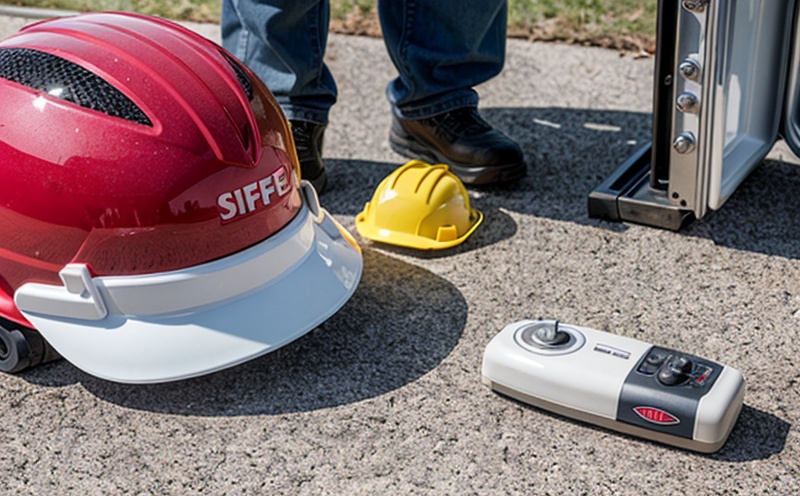ISO 18824 Rescue Boat Engine and Propulsion Testing
The International Organization for Standardization (ISO) has established a comprehensive set of guidelines in ISO 18824 to ensure the safety, reliability, and performance of rescue boat engines and propulsion systems used in maritime environments. This standard is crucial for manufacturers, operators, and regulatory bodies involved in marine safety equipment testing.
The scope of this service encompasses a detailed analysis of the engine's operational characteristics under various stress conditions that it might encounter during real-world scenarios such as heavy seas, sudden stops, or rapid starts. It also includes tests on the propulsion system to ensure that it maintains optimal performance and meets all regulatory requirements for safety and efficiency.
The testing process involves several key steps which are outlined in ISO 18824. These include initial inspections of the engine and its components, followed by a series of functional checks under controlled conditions to simulate operational environments. The tests cover areas such as fuel consumption rates, exhaust emissions, noise levels, vibration analysis, and overall endurance.
For R&D engineers working on new designs or modifications to existing models, this service provides critical feedback on design choices that can affect performance and safety. Compliance officers will find value in ensuring their products meet all necessary standards before entering the market. Procurement professionals can rely on these tests results when selecting suppliers for reliable parts.
The testing equipment used adheres strictly to ISO 18824 specifications, guaranteeing accurate and consistent results. This ensures that each test conducted is as close a representation of real-world conditions as possible. The laboratory follows all relevant international standards such as ISO itself, ASTM International (formerly known as American Society for Testing Materials), British Standards Institution (BSI) and European Committee for Standardization (CEN).
The testing procedure typically starts with an initial inspection where the engine is examined visually and mechanically for any visible defects or irregularities. Following this comes a series of functional checks which involve running the engine through various scenarios that it might face in operation.
| Use Case | Description |
|---|---|
| Engine Start-Up Test | This test evaluates the engine's ability to start quickly and efficiently under different weather conditions. |
| Vibration Analysis | The vibration levels of the engine are measured during operation to ensure they do not exceed safe limits which could lead to structural damage over time. |
| Fuel Consumption Test | Determines how much fuel is consumed by the engine per unit distance traveled, helping operators make informed decisions regarding fuel usage and cost efficiency. |
| Exhaust Emissions Test | Measures pollutants released into the atmosphere from the exhaust system to comply with environmental regulations. |
The service also offers comprehensive reporting, providing detailed insights into each test conducted. This includes data collected during the functional checks and any findings or recommendations for improvement based on these results.
By adhering strictly to ISO 18824 guidelines, we ensure that our testing services meet the highest industry standards. Our experienced team of engineers uses cutting-edge technology and methodologies to deliver accurate, reliable test results every time. This service is essential not only for compliance with regulations but also for enhancing product quality and reliability.
Benefits
The benefits of ISO 18824 rescue boat engine and propulsion testing extend beyond mere compliance; they contribute significantly to enhancing safety, performance, and efficiency in marine operations. Firstly, it helps ensure that all components meet stringent quality control measures before being installed aboard vessels.
- Enhanced Safety: By identifying potential weaknesses early on, we can prevent accidents at sea which could result from substandard equipment.
- Better Performance: Understanding how the engine behaves under various conditions allows for continuous improvement and optimization of designs.
- Increased Efficiency: More accurate fuel consumption rates help operators reduce costs while maintaining operational standards.
The testing process also fosters innovation by providing real-world data that can be used to develop new technologies or refine existing ones. This is particularly beneficial for manufacturers looking to stay ahead of competitors and meet evolving market demands.
Compliance with ISO 18824 ensures that products are safe, reliable, and environmentally friendly, thereby fostering trust among customers and stakeholders alike. This strengthens the reputation of both individual companies and entire industries within the marine sector.
Competitive Advantage and Market Impact
The testing services offered here provide a significant competitive advantage by ensuring that products are not only compliant with international standards but also exceed expectations in terms of performance, safety, and reliability. This gives manufacturers an edge over competitors who may cut corners or fail to meet these stringent requirements.
- Market Leadership: By consistently delivering top-notch testing services, we position ourselves as leaders in the field, attracting more clients and business opportunities.
- Differentiation: Our expertise in marine safety equipment testing helps us differentiate our offerings from those of competitors who may lack such specialized knowledge or infrastructure.
- Customer Satisfaction: Satisfied customers are loyal ones. By providing accurate, reliable test results that help them make informed decisions about their purchases, we enhance customer satisfaction and loyalty.
The impact on the market is substantial as well. Compliance with international standards like ISO 18824 sets a benchmark for industry best practices, encouraging others to follow suit. This not only improves overall safety in marine operations but also promotes sustainable development by minimizing environmental impacts associated with substandard equipment.





